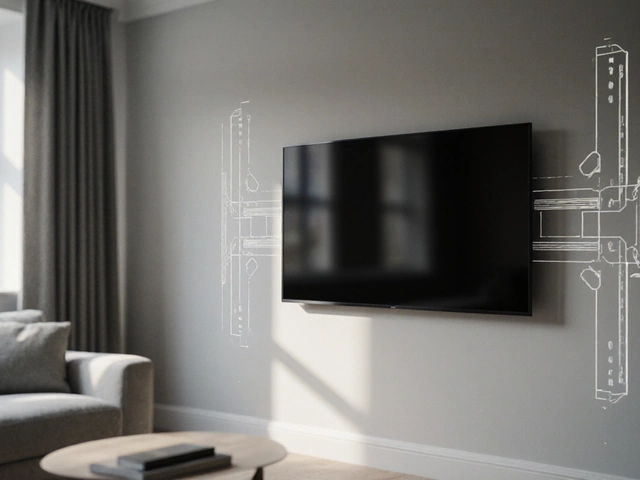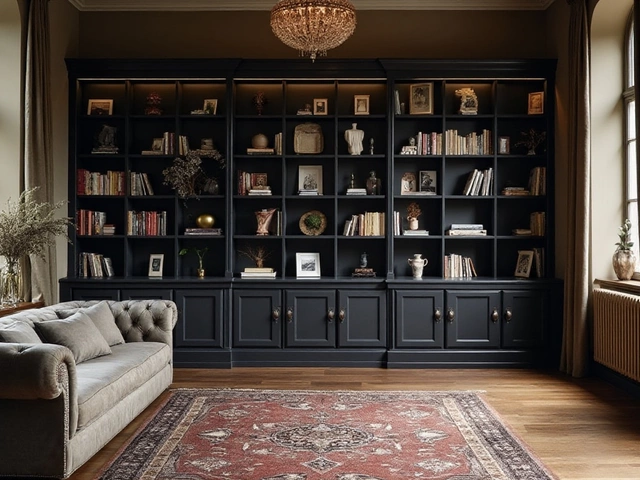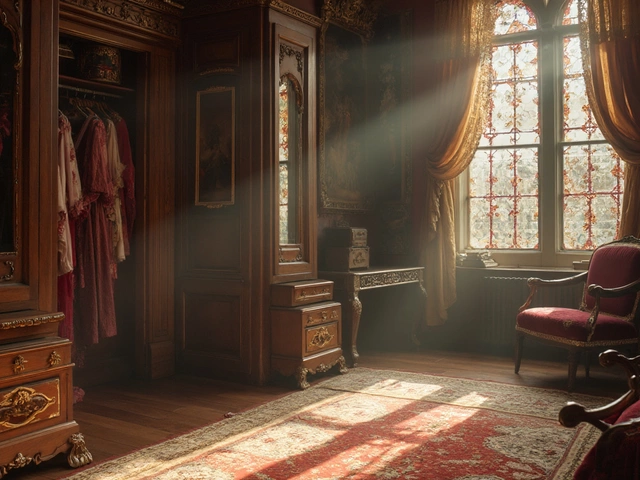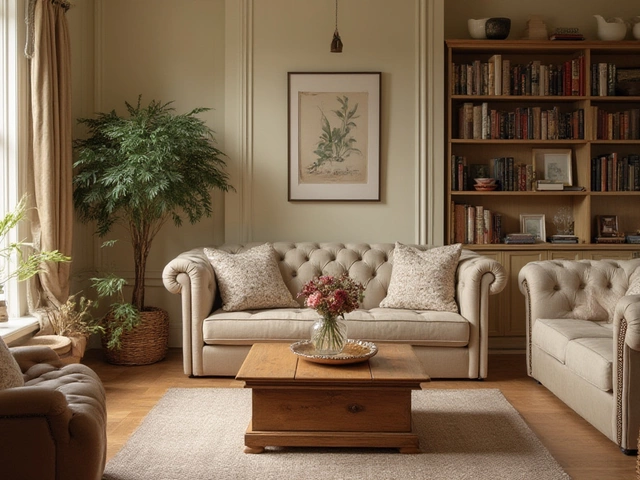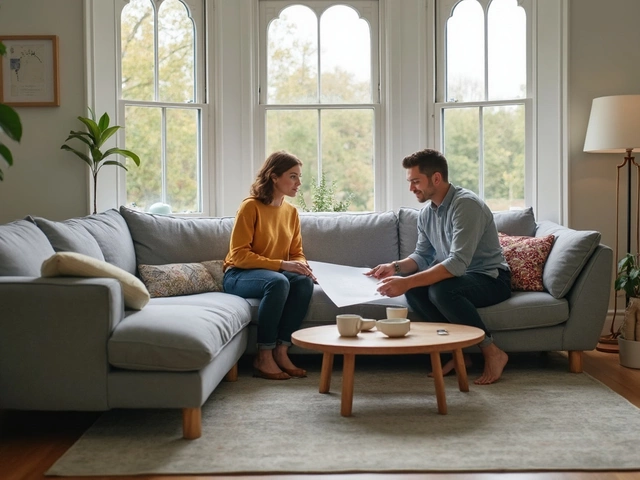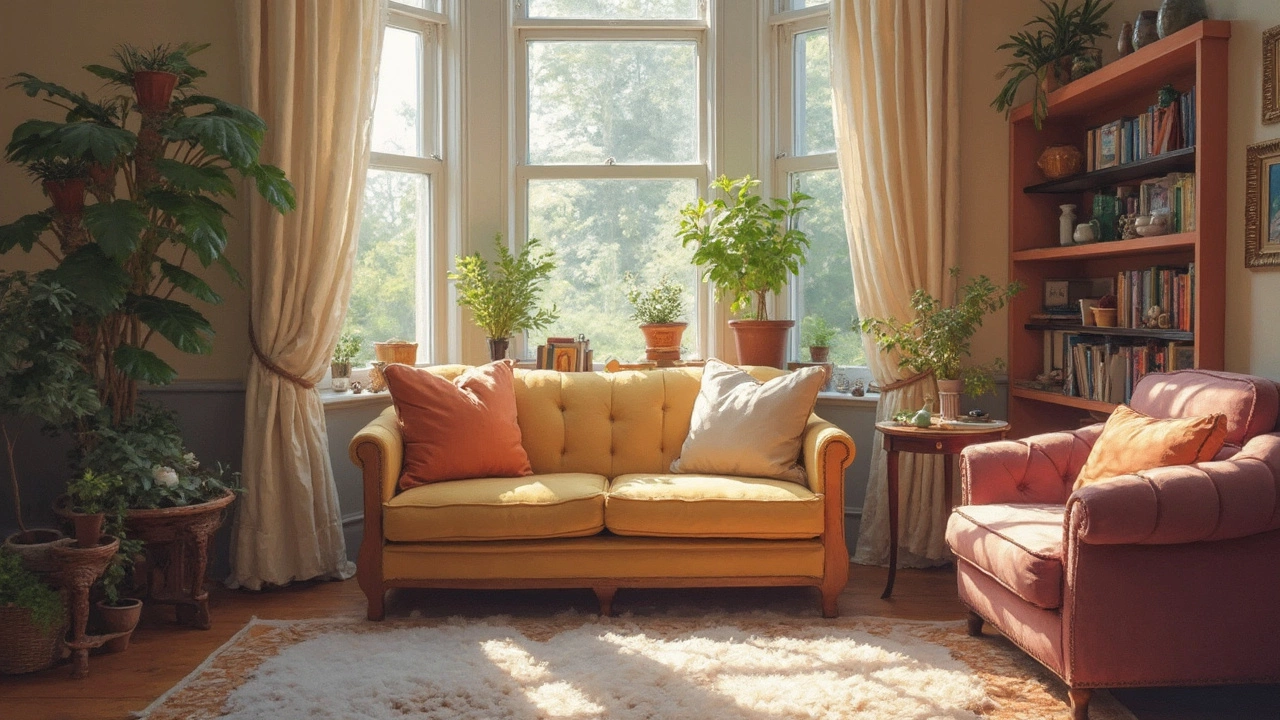 2
Mar,2025
2
Mar,2025
When you're sprucing up your living room, one tricky decision is: should your walls be lighter or darker than your couch? Sounds simple, but it can heavily influence the overall vibe of the room. Let’s unravel this puzzle!
The color of your walls in relation to your couch plays a big role in how the room feels. Lighter walls can make a space seem more open and airy, while darker walls can add depth and coziness. Think about how you want your space to feel—do you want a vibrant, energetic environment or a tranquil haven?
Another thing to consider is how much natural light your room gets. Natural light can lighten up dark walls, making them look softer, while dim lighting can make dark walls feel more intense. Lighter walls in a room with lots of sunlight can feel too bright, almost washed out.
Your choice can also depend on your style. Want a modern, sleek look? Maybe go for darker walls with a lighter couch. Prefer something more traditional? Lighter walls might pair nicely with a cozy, darker couch. It's all about balancing your personal style with practical considerations.
- The Basics of Color Harmony
- Psychological Impact of Colors
- Practical Effects of Light and Dark Walls
- Matching Walls and Couch to Your Style
- Expert Tips for a Balanced Living Room
The Basics of Color Harmony
Understanding color harmony is like having a cheat sheet for designing a balanced living room. Get it right, and your room feels welcoming and well put-together. The first thing to know is the color wheel, which is your best friend when it comes to decorating.
Colors that are opposite each other on the wheel, like blue and orange, are called complementary colors. These create high contrast and can make a bold statement when used together. It’s an exciting choice if you’re looking to make your living room pop!
Then there are analogous colors, which sit next to each other on the wheel. Think of combinations like blue, blue-green, and green. This approach gives a more relaxed and soothing vibe, perfect for spaces where you chill out.
Warm vs. Cool Tones
Ever wonder why some rooms feel cozy while others feel spacious? It’s partly down to warm and cool tones. Warm colors, like reds and yellows, create a lively vibe, while cool colors, like blues and greens, tend to be calming.
If you’ve got a couch color that’s vibrant, pairing it with a lighter neutral wall color could balance things out nicely. On the other hand, if your couch is a subdued grey, maybe a pop of warm wall color adds the spark.
Monochromatic Schemes
For a sophisticated look, you might want to try a monochromatic scheme. That just means using different shades of the same color. Consider pairing a dark blue couch with lighter blue walls. It keeps things simple yet stylish.
| Color Type | Impact |
|---|---|
| Complementary | Bold and contrasting |
| Analogous | Harmonious and soothing |
| Monochromatic | Elegant and cohesive |
Psychological Impact of Colors
Picking the right colors for your home isn't just about aesthetics; it's also about how different shades can make you feel. Colors have their own way of stirring up emotions and setting the ambiance. Before you decide if your walls should be lighter or darker than your couch, let's dive into how colors might affect your mood.
How Colors Influence Mood
Ever felt calm in a blue room or energized in a red one? That's no coincidence. Blue is known for its calming effects, making it a popular choice for bedrooms and relaxation spaces. On the flip side, red can boost your energy levels and create a sense of excitement, perfect for social areas like the living room.
Having lighter walls can give your space an open, fresh, and inviting feel. Light colors like pale yellow or soft pink are great for creating an uplifting atmosphere. Meanwhile, darker walls usually make rooms feel a bit more intimate and cozy—think a snug reading nook with deep green or navy walls.
Color Associations and Perceptions
Colors also have common associations. For instance, white often signifies purity and simplicity, which is why many people prefer white walls to keep everything clean and straightforward. However, too much white might come off as sterile if not balanced well with other elements.
Bold colors like orange and purple carry their own vibes. Orange is all about creativity and enthusiasm, while purple can represent luxury and richness.
Besides, the perception of a color can change based on its shade. A light blue might be calming, while a darker, more saturated blue can feel heavy or imposing.
Using Color to Complement Your Couch Color
If you have a vibrant couch, you might want to tone down the wall color to let it stand out. Conversely, subtle couch colors give you the freedom to experiment more with your wall shades.
The key takeaway? The way colors play off each other matters, especially between large elements like couches and walls. Whatever you choose, aim for a balance that aligns with how you want your home to feel.
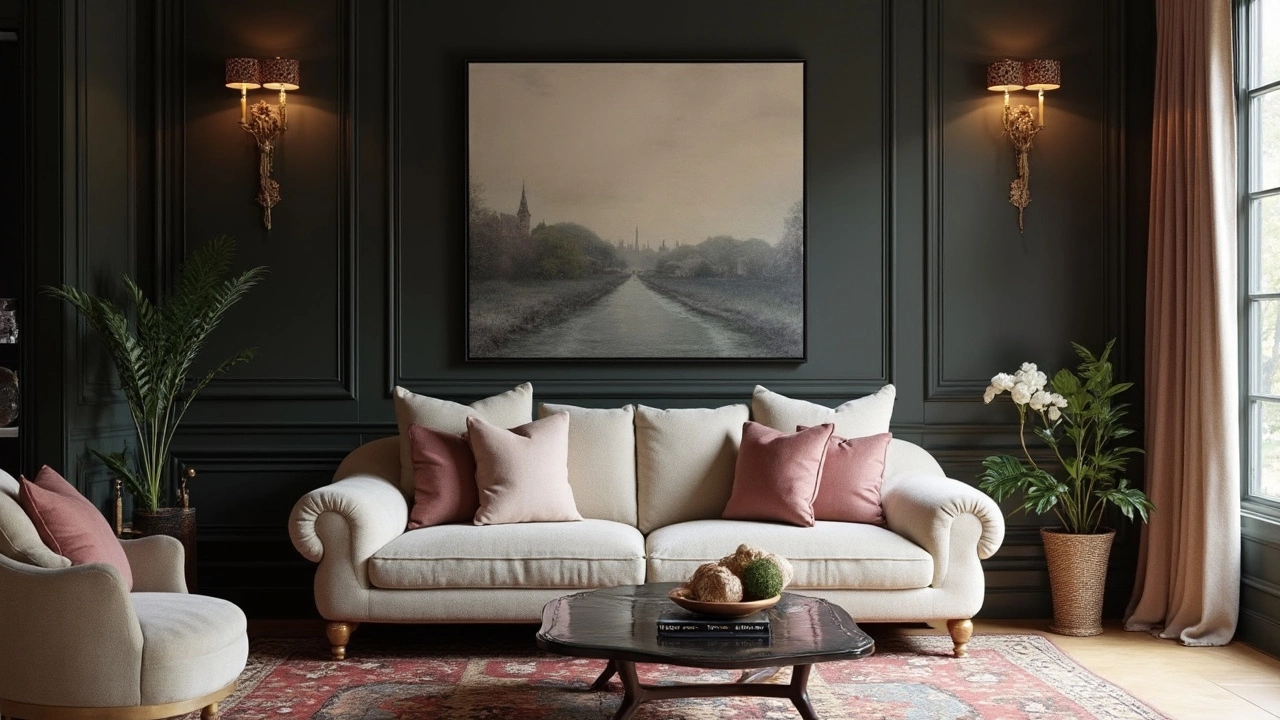
Practical Effects of Light and Dark Walls
Choosing between light and dark walls is more than just an aesthetic decision—it has real effects on your living space. Understanding these impacts can help you make the best choice for your home.
Illusion of Space
Light walls are great at creating the illusion of a larger room. This effect can be perfect for smaller spaces or areas with limited natural light. Lighter walls reflect more light, making the room feel open and airy.
On the flip side, dark walls can add depth and make a room feel snug and intimate. They're fantastic for large rooms where you want to bring the walls in a bit and create a cozy atmosphere.
Mood and Ambiance
The colors you choose can directly affect how a room feels. Lighter walls, particularly in soft, neutral shades, often feel serene and energetic. They're also adaptable, complementing a wide range of decor styles.
Dark walls, however, command attention and can add drama and a sense of luxury. If you love the idea of a moody, chic room, dark walls might be your best bet.
Functionality and Maintenance
From a functional standpoint, consider how the color affects upkeep. Light-colored walls might show dirt and scuffs more easily; however, they're also easy to paint over if you like to redecorate frequently.
Dark walls can mask imperfections and stains, making them a practical choice for high-traffic areas, like living rooms where the couch might see a lot of action.
Balancing With Furniture
Your couch plays a vital role in this decision. A dark couch against a lighter backdrop can pop, creating a striking focal point. Conversely, a light couch against dark walls offers a sophisticated look that's hard to beat.
Quick Tips
- Think about the amount of natural light your room receives.
- Consider using mirrors or metallic fixtures with dark walls to enhance space.
- For a balanced look, choose wall colors that complement your couch and other furniture.
Whether you go for light or dark walls, the key is to create a space that feels just right for you.
Matching Walls and Couch to Your Style
When it comes to harmonizing your wall color with your couch, it’s really about showing off your personal taste. Are you going for a modern, rustic, or maybe a minimalist vibe? Each style has different color cues that subtly tell your story.
Modern & Minimal Styles
If you’re into modern and minimal designs, think sleek lines and a clean look. You’ll likely want to pair a lighter wall with a darker piece of furniture. This dynamic duo can create a visual contrast that's both striking and sophisticated.
"Contrast is key in modern design – it draws attention without being overwhelming." – Anna Stewart, Interior Design Magazine.
Lighter walls can make a small space feel larger, while a darker couch becomes a focal point. Examples of popular colors for this style include crisp whites or soft grays paired with navy or charcoal couches.
Warm & Rustic
For those dreaming of a warm, cozy atmosphere, it’s all about embracing deeper hues. Your go-to might include rich browns, greens, or even muted reds for both walls and couch, but try varying the shades to avoid a monochrome overload. Think of a lighter olive wall with a forest-green couch.
Traditional Touch
Traditional styles often lean towards lighter walls with darker furniture. It creates a timeless look that’s both elegant and inviting. If you’re a fan of classic styles, consider beige walls with dark brown or burgundy couches, enhancing the overall warmth.
- Couch color matching tip: Use accessories like rugs or cushions to tie the wall and couch colors together, making the space feel cohesive.
- Keep it versatile: Neutral walls are easy to pair with various accent pieces, allowing for seasonal or trend changes without a big overhaul.
Figuring out what works best for you involves a blend of personal preference and practical considerations. Take time to experiment and see what suits your home best; the results will be worth it!
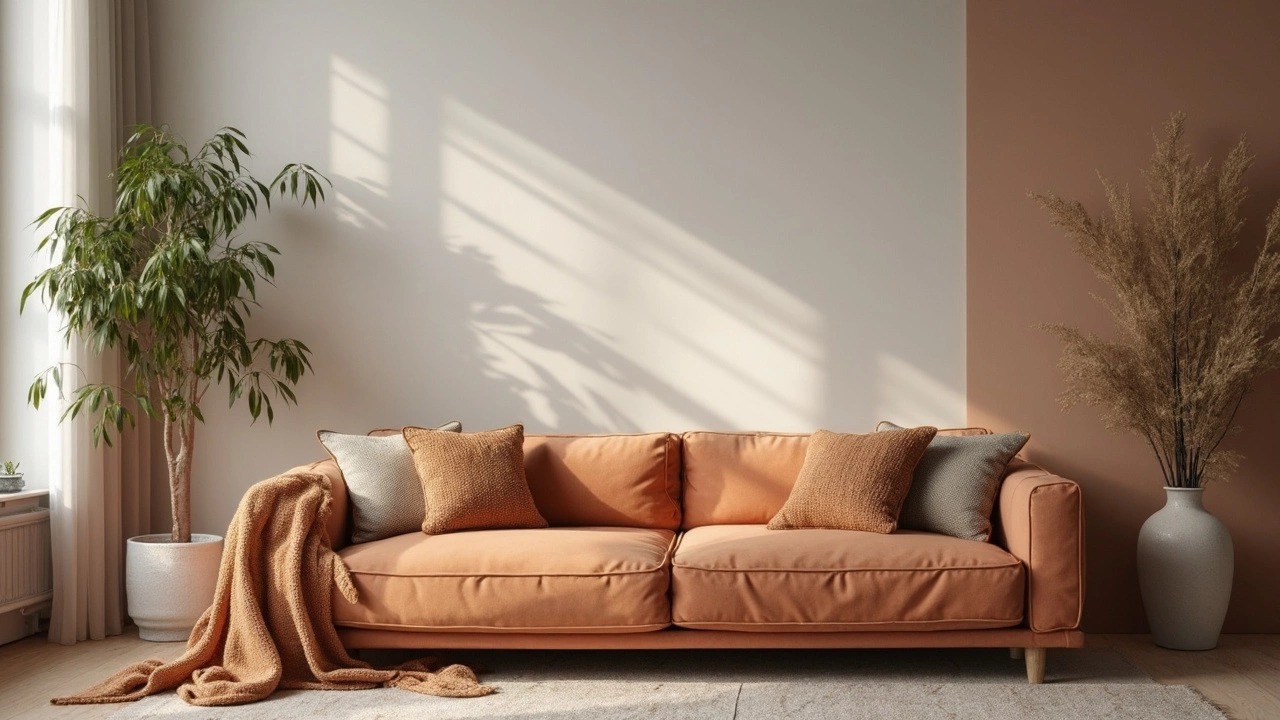
Expert Tips for a Balanced Living Room
Creating a balanced living room isn't just about picking the right shades—it's about making sure everything works together harmoniously. Here are some tips from the pros to help you achieve that perfect blend.
Focus on the Focal Point
Every room needs a focal point, and in many living rooms, it's the sofa or the TV. Position your main pieces—like your couch—in a way that draws attention naturally. For instance, if you've chosen darker wall color, a lighter couch will stand out, creating an inviting space.
Play with Textures
Textures add depth and interest. If your wall color is uniform, use textured fabrics for your couch or use soft furnishings like cushions and blankets to add variety. This contrast can bring about a cohesive look without seeming overwhelming.
Balanced Color Scheme
Stick to a cohesive color palette to bind the room together. A popular rule is the 60-30-10 guideline: 60% of a dominant color (walls), 30% of a secondary color (furniture), and 10% for accents. This method keeps things visually appealing without going overboard.
- 60% Wall color
- 30% Couch and primary furniture
- 10% Accents like cushions and art
Use Lighting Wisely
Lighting can make or break a room's ambiance. Combine overhead, task, and ambient lighting to complement your choices. If your walls are darker, more ambient lighting might be necessary to keep the room feeling inviting, emphasizing central pieces like coffee tables and the couch.
Bringing It All Together
Ultimately, your living room should reflect your personal style while being comfy and functional. By thinking about the placement, texture, and color scheme, along with clever use of lighting, you can craft a room that’s not only visually appealing but also a joy to be in. Don't be afraid to experiment!
